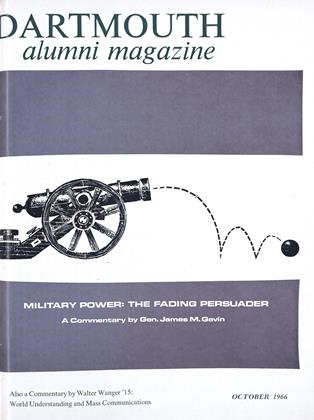By A. A. Be us. Edited byLincoln R. Page '31 and translated byF. Lachman. San Francisco: W. H. Freeman and Co., 1966. 401 pp. $15.00.
Prior to the Second World War, the metal beryllium was largely a chemical and metallurgical curiosity. It had been discovered to form unusual alloys with copper and other metals, but the total annual world consumption of beryllium prior to 1942 was less than a ton. Mineralogists and gemologists were familiar with beryllium, however, as a constituent of several relatively rare minerals, chief of which was beryl. Gem varieties of that mineral are aquamarine and emerald, and the latter, carat for carat, is more valuable than diamond.
The nuclear age has changed all this. Many an alert high school science student knows that beryllium is one of the best possible sources of neutrons, and readers of newsmagazines can tell you that the metal was a vital constituent of early atomic bombs, and that it is now widely used in controlling nuclear reactors. Interest in this exotic metal is, therefore, hardly a happenstance, and the translation of Geochemistry of Beryllium from Russian to English is part of a program, sponsored by the National Science Foundation, to keep American scientists abreast of knowledge in significant areas where the language barrier may otherwise be an overriding obstacle.
A. A. Beus is the Soviet Union's expert in beryllium resources. Lincoln R. Page '31 was selected as editor of this translation largely on the basis of his extensive experience in the study of pegmatites (coarse granitic dikes in which most beryl is found), and also because he was for several years Assistant Chief Geologist of the U.S. Geological Survey, where he directed uranium exploration.
Beus approaches his topic through a series of introductory chapters in which he discusses the physical and chemical properties of beryllium, the detailed mineralogy of its naturally-occurring compounds, and the geochemical rules relating to its occurrence in minerals. Next follows a section in which the beryllium deposits of the world are described under their genetic types as pegmatitic, hydrothermal-pneumatolytic, and hydrothermal. A final theoretical section relates the geochemistry of beryllium to its distribution in the universe and on the earth.
There is no doubt that Beus has examined his subject thoroughly and authoritatively, and that there is no comparable publication on this very specialized but important topic. The translation reads well, and the editor, Dr. Page, is to be congratulated on his meticulous attention to detail, and on his explanatory notes which are so helpful in converting Russian usage to English. Books such as this cannot hope to have a wide distribution nor a wide popular appeal; nevertheless, they forge important links in those specialized areas of knowledge where cross-communication is of such vital significance.
Professor of Geology
 View Full Issue
View Full Issue
More From This Issue
-
 Feature
FeatureMILITARY POWER: THE FADING PERSUADER
October 1966 By LIEUTENANT GENERAL JAMES M. GAVIN -
 Feature
FeatureWORLD UNDERSTANDING: A Job for Mass Communications
October 1966 By WALTER WANGER '15 -
 Feature
FeatureUnderstatement: A Busy Summer
October 1966 -
 Feature
FeatureA Landmark Goes Down
October 1966 -
 Feature
FeatureBoat Rocker
October 1966 -
 Feature
FeaturePress Secretary
October 1966
JOHN B. LYONS
Books
-
 Books
Books77 ANTIPOEMS.
JUNE 1965 By DAVID C. PETRAGLIA '58 -
 Books
BooksCONGRESS AND LOBBIES: IMAGE AND REALITY.
OCTOBER 1966 By DAVID M. KOVENOCK -
 Books
BooksTHE STRUCTURE OF MATTER.
DECEMBER 1965 By FRANCIS W. SEARS -
 Books
BooksPSYCHOPHYSICAL ANALYSIS OF VISUAL SPACE
JULY 1971 By HIROSHI ONO '60 -
 Books
BooksSeeing Tilley Plain
OCT. 1977 By R.H.R. -
 Books
BooksRAIN IN THE DOORWAY
June 1933 By William A. Eddy





